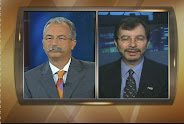
“At the moment the media remains firmly on gloomwatch, which is mildly encouraging. The credit crunch will be over long before the press has finished dissecting it.”
Jonathan Davis
“How investable knowledge got scarce”
Financial Times, February 10, 2008
The flip side of early 2007 is in full force in early 2008. A year ago, goldilocks was all the media rage. Now her evil sister, gloomdilocks is running amuck in media land. Yet, as Mr. Davis implies in his recent excellent FT commentary, a little objectivity wouldn’t hurt. Take for example, the credit crisis.
I recently noted two separate pieces of information from two distinct and unrelated sources re the current credit crisis that should help put things in some perspective.
First, the remainder of the credit crisis is likely to be more of a slow rolling event. This point was noted by two of my Market Forecast panelists in Denver (see blog posting, “Wait ‘til Next Year, Feb. 1, 2008). Why? The answer to this question comes from my interview with S&P’s Chief Economist, David Wyss (see blog posting, “Beyond the Sound Bite: An Interview with David Wyss”, Feb. 6, 2008). In the interview, David points out that most of the must be published data re credit related losses (by the banks and other publicly traded entities) has already been done. One third of the write-offs by his reckoning. However, and this is key, the remaining two thirds sits with those entities who do not have to mark to market every credit derivative product they have on the books as their reporting requirements are significantly different from the high profile, publicly traded ones*.
Who are these entities? The very same ones that are providing liquidity to the high profile, publicly traded entities; the ones that have lots of cash to on hand – foreign entities (including sovereign wealth funds), hedge funds, and private equity.
Investment Strategy Implications
My bet is that three months from now, the media focus will shift from the gloom watch it is currently obsessing on to how resilient the US (and global) economy is turning out be as tax rebates, rate cuts, and a more robust global growth story help bring equities back to some semblance of fair value. Moreover, the credit lock up at the core of the banking system will likely begin to loosen up thereby producing some semblance of a return to credit generating normalcy enabling corporations to function more normally.
With a stock market that is in undervalued and oversold territory, the downside from the low 1300’s appears limited. Should the environment look brighter this spring (as I suspect it will), investors may regret getting too swept up in the media moment of extreme pessimism.
*Moreover, for those private entities who do experience credit related blow ups, the odds that their pain will extend to the larger financial and real economy is significantly less likely than in the banking and publicly traded company domain.














































